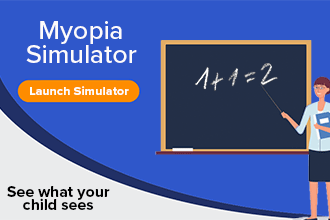Myopia control: How to manage myopia and slow its progression

What is myopia control?
Myopia control is a group of methods optometrists can use to try and slow the progression of childhood myopia. There is no cure for myopia, but there are ways to help control how rapidly it develops or progresses. These include myopia control contact lenses and glasses, atropine eye drops and changes to a child’s habits.
Why should you be interested in myopia control? Slowing myopia progression may keep your child from developing high myopia. High myopia can lead to sight-threatening problems later in life, such as:
Cataracts: both posterior subcapsular cataracts and nuclear cataracts
Myopia management includes all the eye-health care a person with myopia might need. It ranges from diagnosing childhood myopia to addressing its complications in adulthood. Myopia control is a vital part of myopia management.
How does myopia control work?
The most common cause of childhood myopia and its progression is axial elongation of the eye - when the eyeball grows too long from front to back. In general, myopia control works to slow this elongation.
There are several types of effective myopia control, and they can be used one at a time or in combination.
Special myopia control lens designs work by changing how light focuses on the retina. They are available in both myopia control contact lenses and glasses.
Myopia control eye drops are one of the most effective ways to slow myopia progression. Optometrists have prescribed them for more than 30 years with consistent results. However, scientists still don't fully understand why they work.
Changes to daily habits can also help. Sunlight is an important regulator of eye growth, so outdoor time is key.
Prolonged near work can also lead to myopia development and progression. Reducing prolonged periods of near work can lower the risk of myopia development. Taking regular breaks - every 20 minutes or so - during near work is also very important.
Myopia control methods
Currently, there are three broad categories of interventions for myopia control. They each work in different ways to counteract myopia development or progression:
Lenses – myopia control spectacle lenses, myopia control contact lenses, and orthokeratology
Eye drops – Low-dose atropine eye drops
Habit adjustments – Increase time outdoors and reduce prolonged near-work activities
Myopia control spectacle lenses
Over the last 8 to 10 years, there has been a lot of research and progress in the design of myopia control spectacle lenses. Studies show that these new designs can reduce myopia progression by more than 60%.
Myopia control spectacle lenses work by having a clear focus at the centre of the lens but much like myopia control contact lenses, have a different focus at the edges of the lens to keep light in front of the retina - creating peripheral myopic defocus, which sends a signal to the eye not to grow.
Two exciting examples of these lenses are the Essilor Stellest lens and the Hoya Miyosmart lens. Essilor Stellest earned the U.S. FDA's Breakthrough Device designation in 2021 and has been available in Australia and New Zealand since 2022.
Essilor Stellest uses HALT (Highly Aspherical Lenslet Target) technology to create a volume of myopic defocus that follows the shape of the retina. In a clinical study, Essilor Stellest lenses were found to slow down myopia progression by 67% on average, compared to single vision lenses when worn 12 hours per day every day.
Miyosmart uses D.I.M.S. (Defocus Incorporated Multiple Segments) technology to create myopic defocus.
Standard multifocal lenses were commonly used to help slow myopia progression, but studies have shown they don't slow progression nearly as much as the new types of myopia control glasses.
Myopia control contact lenses
Myopia control contact lenses are very different from the ordinary contact lenses that just correct myopia.
Myopia control contact lenses have different focusing power in different zones. They have full focusing power in the centre but less power around the periphery. These lower-power areas ensure that all light entering the eye is focused in front of the retina.
As with the spectacle lenses this is called peripheral myopic defocus.
Research shows that focusing light in front of the retina in this way can help stop the eye from growing longer. In fact, myopia control contact lenses can slow myopia progression by up to 59%.
One example of myopia control contact lenses available in ANZ is the MiSight 1-day lenses by CooperVision.
The multifocal contact lenses used to correct presbyopia can also help slow progression. However, they're not as effective as myopia control contact lenses.
Orthokeratology
Orthokeratology, also known as ortho-k, is a common type of vision correction. Many optometrists also use ortho-k to control myopia progression in children.
Ortho-k uses specialised rigid gas-permeable contact lenses that are only worn overnight. The lenses temporarily change the shape of the cornea during sleep, so vision is clear the next day.
This temporary change also creates peripheral myopic defocus and reduces peripheral hyperopic blur. Research has shown that ortho-k therapy can reduce elongation of the eye.
Atropine eye drops
Atropine eye drops relax the focusing muscles inside the eye. They are commonly used to treat inflammatory eye conditions and in diagnosing strabismus.
Optometrists and ophthalmologists (eye surgeons) also use atropine eye drops to slow myopia progression.
The use of atropine was initially based on the hypothesis that eye fatigue was a factor in myopia. However, later studies pointed to a different answer. They found that atropine likely works due to its effect on receptors in the retina and other parts of the eye.
Research shows that low-dose atropine eye drops (0.02% to 0.05%) can slow progression over three years. This can have a large impact if children use the drops during the peak years of myopia progression.
Some children may have a rebound effect, even with low-dose atropine. This means their myopia progression may speed up again after stopping use of the eye drops. However, the amount of myopia rebound and the number of children who experience it are very small.
Detecting myopia early
The best way to take advantage of myopia control methods is to detect myopia early. This means ensuring that kids receive early childhood eye examinations.
Routine eye exams are important for all kids, even if they don't seem to have vision problems. Myopic kids often don't have obvious symptoms or even realise they are short-sighted.
Routine eye tests are especially important for kids with parents or siblings who have myopia.
Babies should have an eye exam at around 6 months, and preschool-aged kids should have one between 3 and 5. Children 5 and over should have an eye test every 2 years, beginning before they start kindergarten.
Worried about your child's myopia?
Find an optometrist near you and learn about myopia management options.
Gary Heiting, OD also contributed to this article.
Multifocal contact lenses slow myopia progression in children. National Institutes of Health. August 2020.
Myopia control with spectacle lenses with aspherical lenslets: a 2-year randomized clinical trial. Investigative. Ophthalmology and. Vision. Science.; Bao J. et al. (2021).
A 3-year randomized clinical trial of MiSight lenses for myopia control. Optometry and Vision Science. August 2019.
Myopia control with spectacle lenses with aspherical lenslets: a 2-year randomized clinical trial. ARVO Annual Meeting Abstract. Investigative Ophthalmology & Visual Science. June 2021.
Overnight orthokeratology is comparable with atropine in controlling myopia. BMC Ophthalmology. March 2014.
Atropine eye drops BP 1.0% w/v Vistatropine eye drops 1.0% w/v. Electronic Medicines Compendium. November 2016.
Three-year clinical trial of low-concentration atropine for myopia progression study: continued versus washout. Phase 3 report. Ophthalmology. October 2021.
Multifocal contact lens myopia control. Optometry and Vision Science. November 2013.
Retardation of myopia in orthokeratology (ROMIO) study: a 2-year randomized clinical trial. Investigative Ophthalmology & Visual Science. October 2012.
Myopia control with corneal reshaping contact lenses. Investigative Ophthalmology & Visual Science. October 2012.
Prentice award lecture 2010: a case for peripheral optical treatment strategies for myopia. Optometry and Vision Science. September 2011.
Effect of dual-focus soft contact lens wear on axial myopia progression in children. Ophthalmology. June 2011.
Influence of overnight orthokeratology on axial elongation in childhood myopia. Investigative Ophthalmology & Visual Science. April 2011.
A randomized trial of the effect of soft contact lenses on myopia progression in children. Investigative Ophthalmology & Visual Science. November 2008.
Undercorrection of myopia enhances rather than inhibits myopia progression. Vision Research. October 2002.
Recent updates on myopia control. Current Opinion in Ophthalmology. July 2019.
Biological mechanisms of atropine control of myopia. Eye & Contact Lens: Science & Clinical Practice. May 2020.
Page published on Monday, 16 March 2020
Page updated on Tuesday, 31 January 2023
Medically reviewed on Monday, 30 May 2022








